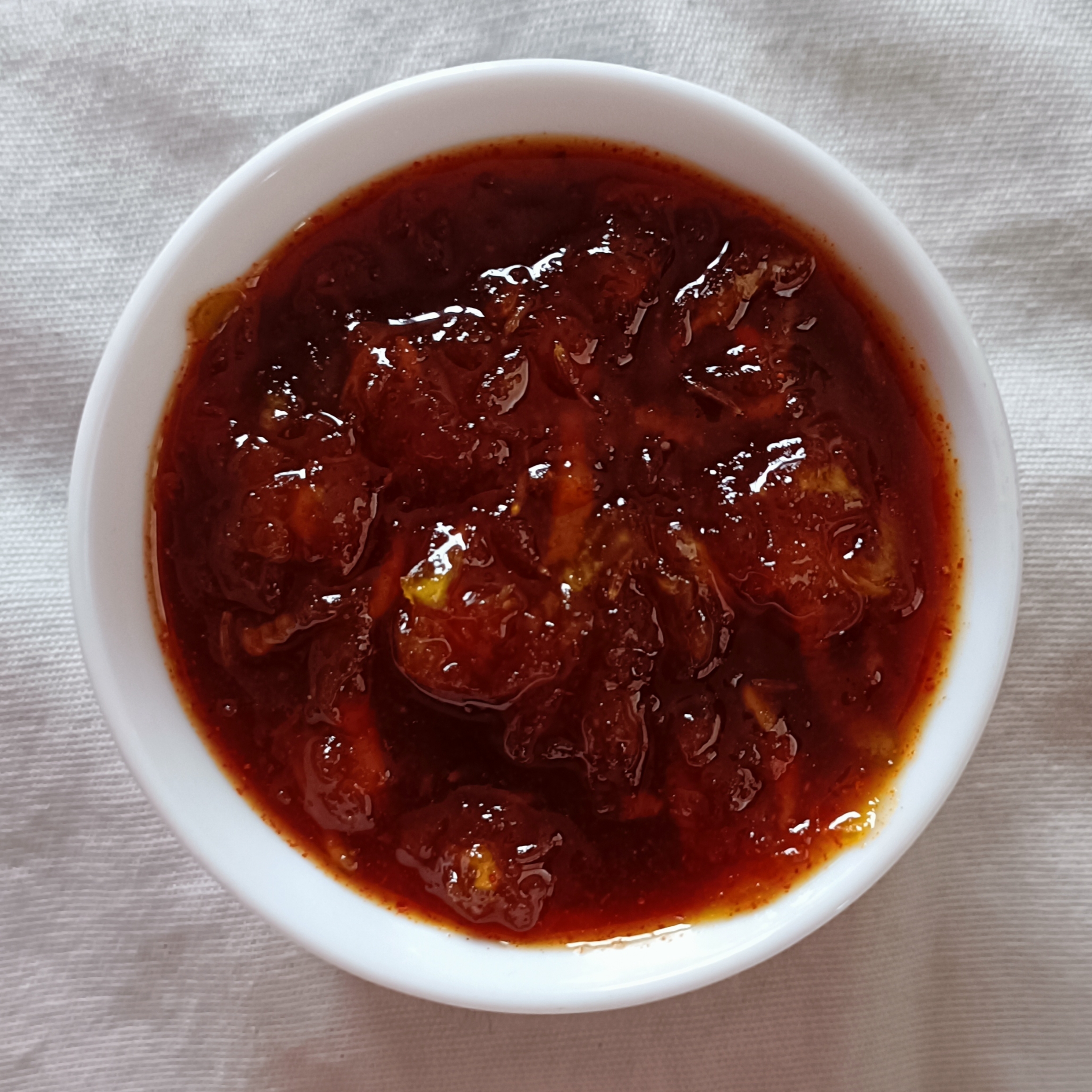This delicious sweet, spicy pickle is a traditional Gujrati recipe that is enjoyed by people all over India. It is usually made with grated raw mangoes mostly with Rajapuri or Vanraj varieties of mangoes but can also be made with the Totapuri variety if the former are not available. If you use Rajapuri mangoes, you will need to use 1250 gms of jaggery for every kilogram of mango as it is more sour than the totapuri variety. It is important to use the raw mangoes immediately after you buy them as they ripen pretty fast if you keep them for a day or two and will not give you the taste of traditional chunda. Indians usually make chunda with sugar instead of jaggery and it isn’t cooked on a stove but is instead put in a jar and kept in the sun for a week to ten days. This variation of chunda made with jaggery is darker in colour and has a slightly different taste than the one made with sugar. I personally find this one tastier. This sweet, sour and spicy chunda is a great addition to any traditional meal and can also be relished with thepla, paratha or other flat breads for breakfast.
Recipe Darshana Muzumdar
Makes around 7 cups
Ingredients
- 1 kg totapuri mangoes (5 cups when peeled and grated)
- 900 gms or 5 cups jaggery
- 1 tbsp salt
- 1 tsp turmeric powder
- 1 heaped tbsp cumin seeds
- 2 tbsp Kashmiri red chilli powder or 1 tbsp other spicy chilli powder of your preference
- ½ tsp asafoetida
- 4 cloves + 1″ piece of cinnamon powdered or ¼ tsp garam masala (optional)
Method
NOTE Its very important to ensure that there is no water or moisture of any kind when you make this chunda. Also, always use a completely dry spoon when you want to remove the ready chunda from the jar.
- Wash and dry the mangoes thoroughly with a clean napkin or better still let them dry in the open air in a cool place. It’s important that they don’t have any moisture or else the pickle will lose its shelf life.
- Once they are completely dry, peel them. The skin of totapuri mangoes is quite thin and they are easy to peel.
- Once you have peeled them grate them using the bigger holes in the grater and discard the kernels.
- Put the grated mango in a thick bottomed steel kadhai or pan in which you’re going to cook it. Make sure there is no water or any moisture in the pan.
- Cut the jaggery into small pieces or grate it.
- Add salt, turmeric and and the jaggery and mix it well. Cover the kadhai and keep it aside for an hour till the jaggery is almost dissolved. The mixture will become thin at this stage.
- Heat the mixture on medium to high heat stirring all the time till it comes to a boil.
- Reduce the heat and continue stirring and cooking it till it begins to thicken. This will take only a minute or so. It will thicken more when it cools down. It should have enough liquid to cover it when it is put in a jar.
- Turn down the heat to minimum and add the cumin seeds, red chilli powder, asafoetida and the cloves-cinnamon or garam masala powder if you’re using it. Kashmiri red chilli powder gives it a beautiful red colour and just enough spice. But you can still use any other chilli powder if you can’t find it.
- Give the mixture a quick mix and turn off the heat.
- Transfer the ready chunda into clean and dry glass jars. This delicious condiment doesn’t need to be refrigerated and will last a year or more.
NOTE This chunda has a shelf life of a year if you have taken care to remove all moisture while cooking it.
For the Whole-Food Plant-Based (WFPB) version:
- Do not peel the mangoes. Personally I think the chunda made with the peel doesn’t taste as good as the one made without it.
- Use dates instead of jaggery.
- Use unrefined or rock salt.
- This chunda may not last very long, so make small batches for instant consumption.









Share this:
- Click to share on Facebook (Opens in new window)
- Click to share on WhatsApp (Opens in new window)
- Click to share on Twitter (Opens in new window)
- Click to share on Pinterest (Opens in new window)
- Click to share on LinkedIn (Opens in new window)
- Click to share on Reddit (Opens in new window)
- Click to share on Tumblr (Opens in new window)
- Click to share on Pocket (Opens in new window)
- Click to share on Telegram (Opens in new window)
- Click to print (Opens in new window)

